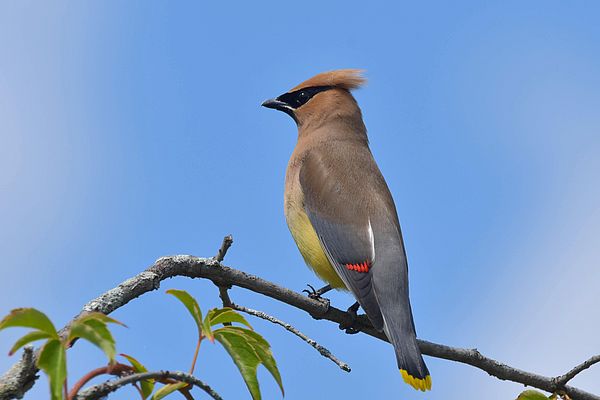Cedar Waxwing – One of North America’s Most Frugivorous (fruit eating) Birds
Article by Ava Steenstrup
These beautiful birds are elegant in appearance and have remarkably silky-smooth plumage. Male and female waxwings look the same and both have a crest that often lies flat and droops over the back of the head. Adults have a pale brown head, a narrow black mask, gray on the back and wings, pale yellow on the belly, white under tail coverts, and a dark gray tail with a bright yellow tip.
The first half of their name “cedar” comes from their fondness for cedar berries. The name “waxwing” comes from the waxy red tips on the end of their secondary wing feathers.
Waxwings are herbivores (frugivores) and carnivores (insectivores). They eat berries, crabapples, and other small fruits that they select with their bills while perched. Unlike most fruit-eating birds that regurgitate seeds, cedar waxwings digest the entire fruit and the seeds are eventually dispersed in their droppings. During the breeding season and when trees are not bearing fruit, they forage for insects by catching them in mid-air or by gleaning them from bushes and trees. They have also been observed eating flower petals, nectar, and sap from trees.
Cedar Waxwings are monogamous during each breeding season and have an interesting courtship ritual. The male dances for the female and gives her a flower, fruit, or insect. If the female is interested in becoming the mating partner, the gift will be passed back and forth until she eventually eats it. She then chooses a nesting site followed by nest construction.
These birds are very sociable and are often found in large flocks which helps them find food more efficiently and protect themselves from predators. They can be found in forests and wooded areas, forest edges, orchards and open clearings like farmlands and suburban backyards. They are nomadic, following the availability of fruits as opposed to migrating seasonally.
Cedar waxwings do not have a distinct song but rather make a soft, high-pitched ascending trill. They call constantly, particularly in flight, and are often heard before they are seen.
Did you know? Cedar Waxwings can become intoxicated from eating overripe berries that have started to ferment and produce alcohol!

